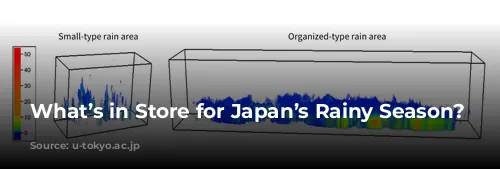The rainy season in Japan, fondly known as tsuyu or baiu, is a period deeply embedded in the nation’s cultural fabric, reminding people of the harmony between nature and its cycles. But with global warming on the rise, this familiar period of dampness could be in for a significant shift.
Will Japan’s rainy season become more intense or frequent in the future? What does the future hold for the tsuyu? Let’s delve into the science behind this question.

Understanding the Dynamics of the Rainy Season
The rainy season, a phenomenon stretching from May to July, is not unique to Japan. It graces much of East Asia as well. This period of consistent rainfall is a consequence of the delicate dance of atmospheric pressure, wind patterns, and temperature gradients.
As the sun ascends higher in the sky, the Earth’s surface heats up. This warmth causes the atmospheric pressure over land to drop below the pressure over the ocean, creating winds that flow from the sea towards the continent. These winds carry moist, warm air from the south.
At the same time, the Tibetan high-pressure system pushes warm, moist air from the continent’s southern region. High above, the jet stream, a fast-moving current of air, divides the atmosphere into tropical and temperate zones. This forms a weather front, where air masses of differing temperatures and humidity collide.
When this moist air is pulled into this front, it becomes unstable, causing vertical mixing and triggering prolonged periods of rain. This dance of forces creates the baiu weather front. As summer approaches, the Pacific high-pressure system strengthens, pushing the jet stream northward and marking the end of the rainy season.

Classifying Rainfall Patterns
The rain that falls during the rainy season doesn’t always fall in the same way. Using satellite data from the Global Precipitation Measurement (GPM) and Tropical Rainfall Measuring Mission (TRMM), researchers have classified the rainfall events in the rainy season into three distinct types:
1. Small-type rain: This type is short-lived, accompanied by thunder, and common in regions with high sea surface temperatures.
2. Organized-type rain: This type covers widespread areas for extended periods, lacks thunder, and is a common cause of torrential rain.
3. Midlatitude-type rain: This type is relatively light and associated with extratropical cyclones.
Each type of rain is influenced by the interaction of low-altitude warm and damp air, the jet stream, and the specific atmospheric conditions.

Predicting the Future of Rainfall
Climate models are tools that use complex algorithms to simulate the behavior of the Earth’s climate system. Researchers have used these models to predict the future of rainfall events during the rainy season.
Their projections, based on the worst-case scenario for future global warming, show an alarming trend:
- Organized-type rainfall, already prevalent in western Japan, is expected to spread to the Tohoku and Kanto regions within the next century.
- Small-type rainfall is also projected to increase across all regions, particularly along the Pacific Ocean coastline from Kyushu to Kanto. This suggests a potential rise in sudden, violent thunderstorms.
- More than 90% of the climate models used in these projections have shown similar trends, strengthening the credibility of these findings.
These predictions point to a future where Japan’s rainy season could be marked by more intense and frequent downpours, posing a greater risk of disasters.
Beyond Japan: A Global Perspective
While the rainy season is a distinctive feature of East Asia, similar phenomena exist in other parts of the world, such as South America. Further research aims to determine if the trends observed in Japan are reflected in these other regions and to investigate any differences in their behavior.
Understanding the changes to our climate and their implications for future rainfall patterns is crucial for preparing for the challenges ahead. As the climate continues to evolve, adapting to the changing patterns of the rainy season will become increasingly important for Japan and beyond.

